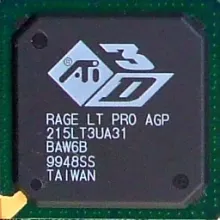
The ATI Rage 128 chip was a significant graphics processing unit (GPU) released by ATI Technologies in 1997. It marked a crucial step in the evolution of graphics cards by integrating 3D acceleration, 2D graphics, and DVD playback capabilities into a single chip. This integration allowed for cost-effective graphics solutions and improved multimedia performance for consumers.
The ATI Rage 128 featured support for both AGP and PCI interfaces, making it compatible with a wide range of systems. It offered hardware acceleration for 3D graphics and supported features like bilinear filtering and texture mapping. While not as powerful as some of its competitors at the time, the Rage 128 played a role in driving the adoption of 3D graphics in mainstream computing.
The chip faced competition from NVIDIA's RIVA TNT series, which often outperformed the Rage 128 in 3D benchmarks. In response, ATI released the Rage 128 Pro, a refined version with higher clock speeds and improved performance. The Rage 128 Pro helped ATI remain competitive in the market and demonstrated ATI's commitment to refining its technology.
The ATI Rage 128 chip's significance also lies in its role as a precursor to ATI's Radeon series of graphics cards. The technology and experience gained from the Rage 128 contributed to the development of the Radeon line, which would become ATI's flagship series and continue to evolve over the years.
